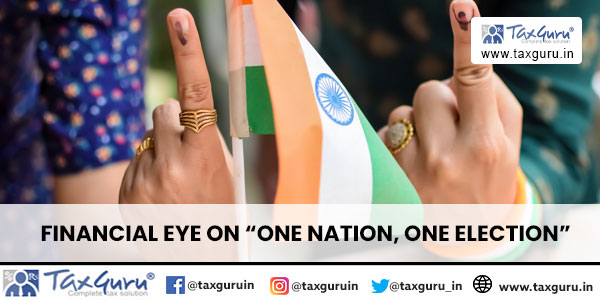The “One Nation, One Election” idea is all about bringing together the national and state elections for one big event. This approach could save India a lot of money! By holding elections simultaneously, we can cut down the costs and resources needed for running multiple polls. This means savings in administrative expenses, security, logistics, and staffing. Plus, having simultaneous elections might lead to better governance since the government can focus on important long-term policies and economic reforms that benefit all of us.
The main idea is to hold national and state elections together every five years instead of having them at different times throughout the year. This concept has been discussed in India for quite a while. Supporters say it would improve governance, reduce the political ups and downs from constant campaigning, and help save money. However, some critics point out the challenges of managing nationwide elections all at once, the risk of national issues overshadowing local concerns, and making sure everyone gets fair representation.

♦ How It Could Save Money:
Bringing national and state elections together can save money, helping both the government and political campaigns. By having one election instead of many, we can reduce interruptions to our daily lives, make things run more smoothly, and lighten the load on government resources. Plus, this approach can create a more stable political environment, which is great for boosting investor confidence and supporting economic growth. On top of that, synchronized elections help with better budget management, ensuring resources are used wisely for national development. It’s a win-win for everyone!
1. Lower Costs for Elections: Running separate elections for the national government and state assemblies can be very costly. If we merge them into one election, we could see significant savings that could be funneled into development projects or other important national needs.
2. Reduced Campaign Costs: Political parties and candidates usually spend a lot on their campaigns. By having a single national election, we could lower overall campaign expenses since everyone would be focusing on one big event instead of spreading their efforts out over different times.
3. Less Disruption to Daily Life: The preparations and security measures for multiple elections can disrupt regular government services, which affects everyday life and the economy. Holding one election could help keep things running smoothly and lead to better outcomes for everyone.
4. More Efficient Processes: Staggered elections create extra work for government resources, raising costs and taking more time. With one unified election, the Election Commission can focus on promoting economic stability without juggling multiple election cycles.
5. Boosted Investor Confidence: A stable political environment tends to attract investors. Frequent elections can create uncertainty. By synchronizing elections, we can establish a more stable political climate that appeals to both local and international investors, benefiting our economy.
6. Stable Governance: Having too many elections can lead to a lot of leadership changes, which can shake market confidence and deter foreign investments. By aligning elections, we can create a more stable governance structure that helps implement policies effectively and encourages economic growth.
7. Better Budget Management: Conducting elections together can lessen the financial burden that comes with running elections separately. This allows governments to manage their budgets and resources more efficiently, which is great for overall fiscal health.
♦ What About the Costs?
While there might be some initial costs to get started, the long-term savings could more than make up for them. Implementing simultaneous elections would require investment in voter education, training, and awareness campaigns. Additional security and law enforcement measures would increase costs, along with legal expenses for updating electoral laws. Political parties may face higher campaigning costs to cover both national and state elections simultaneously.
1. Training and Awareness: We’ll need to run educational campaigns for voters and polling officials, which means a budget for training sessions, workshops, and materials.
2. Security and Law Enforcement: Holding elections at the same time would require more law enforcement, leading to additional costs.
3. Legal Costs: Updating electoral laws and making administrative changes for simultaneous elections would need some significant legal investment.
4. Political Party Campaigning Costs: Political parties may need to ramp up their efforts to cover both national and state elections at the same time, which could lead to higher expenses.
5. Infrastructure Investment: The Election Commission will need resources to manage simultaneous elections effectively, including staffing and materials.
♦ Potential Savings for the Election Commission:
The Election Commission of India spends quite a bit on conducting elections, covering areas like security, logistics, polling stations, transportation, and personnel. Holding separate elections can add up to thousands of crores.
E.g., Lok Sabha elections can cost around ₹4,500–₹5,000 crore, while state assembly elections range from ₹1,000–₹1,500 crore. If we hold elections together, the Election Commission could save a substantial portion of these costs by:
→ Reducing the need for multiple rounds of security forces and election personnel.
→ Cutting down on repeated expenses for transportation, materials, and logistics.
→ Minimizing administrative costs tied to setting up polling places and monitoring.
We estimate that holding elections simultaneously could save the country about ₹4,000–₹5,000 crore over time!
Public opinion surveys show a lot of support for the “One Nation, One Election” idea. A CNN-News18 survey found that around 80% of people are in favor of having simultaneous elections for the Lok Sabha and state assemblies, with 81% believing it could lead to significant savings for the government.
The views expressed are the personal views of the author only and are for educational purposes only. Therefore, the same should not be considered as the final opinion on the subject matter. There may be other views also. So, the readers are advised to consider all the points before relying upon the above write-ups.





